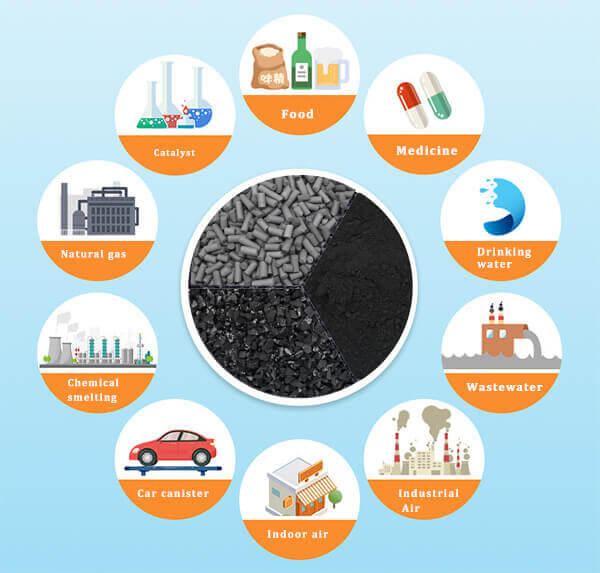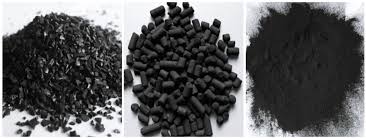Activated carbon and its irreplaceable role in water purification
Activated carbon is one of the advanced and widely used materials in water treatment processes. Due to its unique properties, it has gained a significant position in the water purification industry. With its exceptionally high surface area and excellent adsorption capacity, this material can remove a wide range of contaminants. In this article, we will take a closer look at the applications of activated carbon in water treatment, its key characteristics, and the importance of selecting the right type to optimize the performance of filtration systems.
What is Activated Carbon?
Activated carbon is a porous material specifically designed for the adsorption of chemicals, pollutants, and impurities. It is typically produced from natural sources such as coal, wood, or coconut shells and undergoes processes like carbonization and activation to develop a highly porous structure. The physical and chemical properties of activated carbon make it one of the most effective adsorbents in the water treatment industry.

The Production Process of Activated Carbon
The production of activated carbon is carried out in two main stages:
-
Carbonization: In this stage, the raw materials are decomposed in a high-temperature, oxygen-free environment to produce raw carbon.
-
Activation: The raw carbon is activated using steam or chemical agents to increase its porosity and surface area. This crucial process significantly enhances its ability to adsorb contaminants.
Applications of Activated Carbon in Water Treatment
Activated carbon, due to its high efficiency in removing various contaminants, is widely used in water treatment. Some of its main applications include:
- Removal of Chlorine and Byproducts:
Chlorine is one of the most commonly used disinfectants in water treatment. However, the presence of chlorine in water can lead to unpleasant odors and tastes. Activated carbon improves water quality by adsorbing chlorine and its byproducts.
- Adsorption of Organic Materials and Chemical Contaminants:
One of the notable advantages of activated carbon is its ability to adsorb complex organic materials, agricultural toxins, pharmaceuticals, and industrial chemical pollutants. This feature is particularly effective in removing resistant contaminants from drinking and industrial water.
- Reduction of Unpleasant Odors and Tastes:
Organic and inorganic compounds present in water can cause unpleasant odors and tastes. The use of activated carbon in water treatment systems adsorbs these compounds, resulting in clear water with a natural taste.
- Removal of Heavy Metals:
Activated carbon can help remove heavy metals such as lead, mercury, and cadmium from water. This feature is especially important in industrial applications and groundwater treatment.

Types of Activated Carbon Suitable for Water Treatment
Choosing the appropriate type of activated carbon is crucial depending on the intended application. Some of the common types of activated carbon for water treatment include:
- Powdered Activated Carbon (PAC):
Powdered activated carbon (PAC) has a high surface area due to its small particle size and is used in both municipal and industrial water treatment. This type of carbon is particularly effective for removing organic pollutants and chemicals.
- Granular Activated Carbon (GAC):
Granular activated carbon (GAC) is produced in larger particles and is used in both residential and industrial water filtration systems. Due to the faster water flow through it, this type of carbon is suitable for high-volume applications.
- Extruded Activated Carbon (EAC):
This type of carbon, which is produced in cylindrical shapes, is used in systems with high pressure and specific industrial applications.

Advantages of Using Activated Carbon in Water Treatment
-
High Efficiency in Adsorbing Contaminants:
The porous structure of activated carbon enables it to adsorb a wide range of contaminants effectively. -
Environmentally Friendly:
This material is natural and can be recycled after use. -
High Flexibility:
Different types of activated carbon are designed to meet specific water treatment needs. -
Cost-Effective:
Compared to other water treatment methods, activated carbon is more affordable.
Key Considerations for Purchasing Activated Carbon for Water Treatment
- Consideration of Contaminant Type:
The selection of the type of activated carbon should be based on the type of contaminants present in the water. For example, powdered activated carbon (PAC) is more suitable for removing organic compounds.
- Quality and Standards:
Activated carbon should meet reputable international standards to ensure its efficiency and safety.
- Consultation with Experts:
Before purchasing activated carbon for water treatment, it is recommended to consult with experts in the field to choose the most suitable type for your specific needs.
Activated Carbon for Water Treatment Sales
Artin Azma Mehr Company, leveraging expertise and experience in the field of water treatment raw materials, is ready to provide the best types of activated carbon for various applications. The company ensures that the products offered meet high quality standards and international certifications. The technical team at Artin Azma also provides necessary consultation to help customers choose the most suitable type of activated carbon for water treatment.
